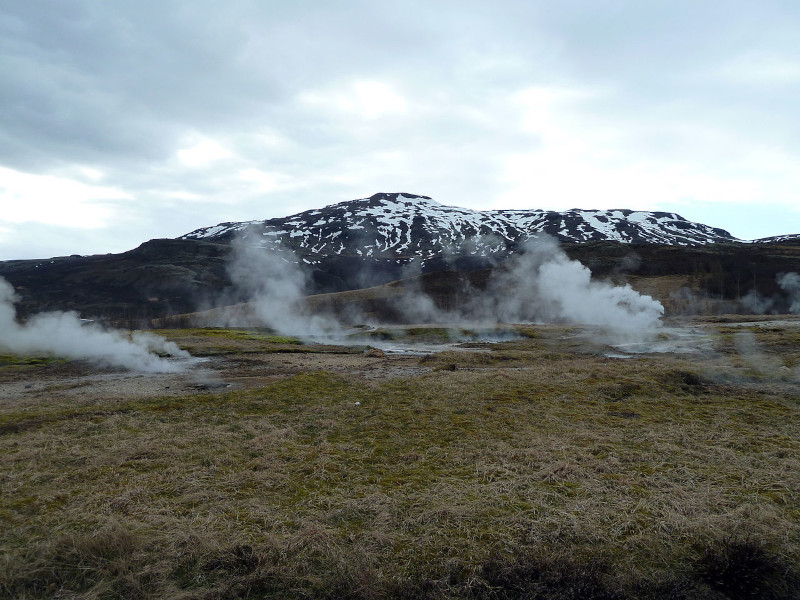Haukadalur Geothermal Area Facts
- The term of Haukadalur Geothermal Area serves as the translated name for this remarkable creation of geological forces. It derives from an very similar word in old norse. That was the term Haukadalr, which meant either hawk dale or valley of hawks.
- The site forms a remarkable region of geological beauty in an area of the world well known for such features. That’s because this wonder of Nature formed in what we now know as the southern portion of the magnificent country of Iceland, in Europe.
- Somewhat intriguingly, this astonishing region of the world also holds an important place in scientific history. That’s due to the amazing fact that one of the geysers found in the area actually holds its own, independently impressive status.
- In fact, it represents one of the first geysers discovered by modern man. Along with it, the earliest known recorded mention of the spectacular landscape features occurred in ancient times. In point of fact, this written notice of the site took place in 1294.
- This occurred due to the fact that, at that time, an earthquake activated numerous hot springs within the region. Even prior to this event, though, the Haukadalur Geothermal Area played an important role in the culture of the surrounding region.
- In modern times, however, its principal role there switched to an economical one. That’s due to the fact that the site has been a major attraction for tourists since the 18th century. Given its unique nature, it still continues to excel in that regard.
Related Articles
Haukadalur Geothermal Area Origins and Nature
In geological terms, the otherworldy beauty of the Haukadalur Geothermal Area formed in extremely recent times. Uncovered evidence indicates that the marvel of Nature originally formed at the end of the last Ice Age. That puts its age at between 11,000 – 12,000 years.
The earth isn’t finished with the mesmerizing site yet, though. Occasional earthquakes in the region continue to alter its nature even today. These events typically remain minor. The last such recorded earthquake in the region occurred in July of 2000.
Incredibly, an impressive 40 geothermal features, of various types, currently remain known to science in the remarkable region. It’s fully possible that others may await discovery. It comes as no surprise, given its nature, that all of these qualify as volcanic in nature.
These multiple features include such formations as multiple geysers of varying sizes, several hot springs, fumaroles, and even mud pots. Understandably, the largest of the geysers in the Haukadalur Geothermal Area itself draws great deal of well-deserved interest.
That amazing formation, named Strokkur Geyser, and many of the geysers in the region, have one fascinating trait in common. That’s because they appear comparatively regular in the timing of their eruptions. In this, they’re like Old Faithful, in the United States.
Haukadalur Geothermal Area Distinctiveness
As if everything mentioned previously wasn’t enough, the awe-inspiring Haukadalur Geothermal Area has even more to offer. That holds true due to the presence of a very specific occurrence, making several of the small springs in the area appear quite unique.
The water within them qualifies as sodium bicarbonate thermal water. That happens because of the extremely high concentrations of this chemical compound. Yet, the presence of this mineral isn’t the only baffling part of the nature of the liquid present.
That holds true due to yet another mind-boggling status about the seemingly inhospitable landscape . To the continued amazement of researchers, these same streams within the area also contain comparatively high concentrations of the radioactive gas radon.
But evolution takes factors and conditions of all sorts into consideration, even at sites such as the Haukadalur Geothermal Field. Because of the resourcefulness and adaptability of life, not even this site is exempt from the wonders of the development of life.
Living within this unique environment are numerous species of microorganism and algae. All adapted to survive within the unique water and extreme heat. Some of them now remain incapable of surviving in water temperatures measurements below 158 F (70 C).
Features Sharing Its Region
Check out our other articles on 3 Wonderful Woody Shrubs of Australia, Serval, Cradle Mountain, Bird’s Foot Violet, Evening Cicada, Hellbender Salamander, Tiger Shark, Jamaican Iguana

